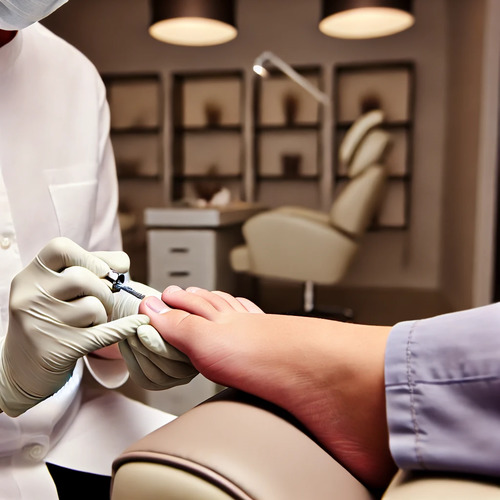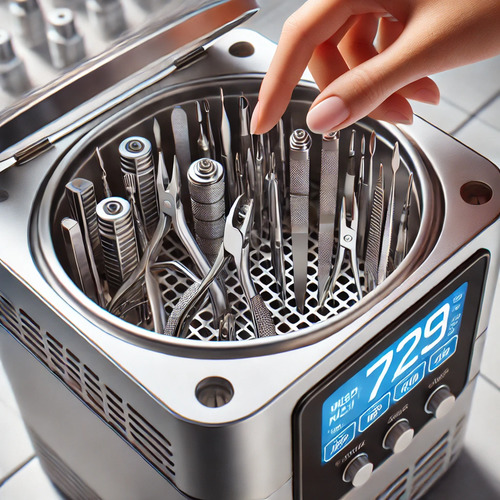Salon pedicure is not only a pleasant but also a relaxing procedure that allows for foot care and improves their appearance. However, it is important to remember the potential risks associated with this procedure. One of the main risks is the possibility of infection. Insufficient treatment and sterilization of tools can lead to fungal infections, as well as more serious diseases like hepatitis or HIV.
To minimize these risks and ensure a safe experience, we offer you some recommendations before visiting a salon. If you want to learn more about what a salon pedicure is, as well as its advantages and disadvantages, read our article.
What is a salon pedicure?
A salon pedicure is a professional foot and nail care procedure performed in specialized beauty salons. It includes cleansing, exfoliating, trimming, and filing the nails, as well as thorough treatment of the cuticles and sidewalls. The pedicure process pays special attention not only to the nails but also to the condition of the soles and the spaces between the toes. Professional care involves the removal of calluses, hard skin, and cracks, ensuring smoothness and health for the skin of the feet.

To achieve the best results, various cosmetic products are used to moisturize and nourish the skin, helping to keep it soft and prevent dryness. Additionally, a salon pedicure often includes a foot massage, which promotes relaxation and improves blood circulation. At the final stage, clients can choose nail decoration using polish or designs according to their preferences. A salon pedicure not only makes the feet look well-groomed but also brings pleasure and relaxation, creating a sense of comfort and self-care.
Advantages and Disadvantages of Salon Pedicures
Advantages:
1. Service. In studios and beauty salons, qualified professionals work, performing their tasks with high quality and attention to detail. After just one session, they can transform even the most neglected feet, helping clients eliminate aesthetic problems and restore a well-groomed appearance.
2. Time-Saving. Achieving perfect results at home requires considerable time and effort. Visiting a salon helps save this time, which you can then dedicate to yourself and your loved ones.
3. A Wide Selection of Products. Building a collection of polishes, gels, and other materials for a complete pedicure can be a complex and costly task. Therefore, many people prefer to stick to just two or three shades. However, a nail service master is always ready to offer you a variety of colors, shapes, and designs that suit your mood and the occasion. Nothing compares to the joy of experimenting and discovering something new!
4. Additional Services. Salons offer not only standard foot care but also a range of additional procedures, such as massages with aromatic oils, spa treatments, and paraffin therapy. These procedures not only help maintain hygiene and an impeccable appearance of the feet but also provide a relaxing effect, offering moments of true comfort and self-care.
Disadvantages:
1. High Cost. The cost of professional pedicures may seem high, but it’s important to remember that quality and safety are behind that price. Certified specialists use only high-quality materials and sterile instruments, ensuring a high level of service. Don’t skimp on your health—taking a responsible approach to self-care is essential for maintaining the comfort and beauty of your feet.
2. Injuries. Inexperienced specialists often injure soft tissues, trim the cuticle too much, or accidentally nick the skin, which can lead to unpleasant consequences. They may also fail to understand clients' desires and may not be able to offer optimal solutions. Therefore, it’s crucial to choose a specialist carefully: pay attention to reviews, and inquire about the availability of licenses and certificates for the beauty salon's staff.
3. Risk of Infection. Improper handling and sterilization of instruments can lead to serious consequences, such as fungal infections, hepatitis, HIV, and other diseases. Always ensure that the specialist uses disposable gloves and maintains a clean workspace. The opening of the craft package should only occur in your presence. You have the right to review the logs for the quality of pre-sterilization processing and to check the operation of air or steam sterilizers.
Infection is a dangerous disease that can have serious health consequences. To avoid this unpleasant occurrence, follow the recommendations below.
How to Avoid Risks of Salon Pedicures
If you prefer not to do pedicures at home and plan to treat yourself at a salon, there are several important recommendations to keep in mind.
First and foremost, choose a salon with an excellent reputation and positive reviews, even if it's located far from your home or workplace. Pay attention to what clients say about hygiene, the cleanliness of the salon, the sterilization of tools, and the professionalism of the staff. When you book your appointment, make sure to mention that you do not want your cuticles trimmed, as any damage to the skin can become a source of infection.

When communicating with the pedicure technician, politely ask about the sterilization of tools. You can also request that your nails not be cut too short and that their edges not be rounded. If you experience discomfort or pain during the procedure, do not hesitate to ask the technician to pause.
Violations of sanitary standards in a salon can lead to bacterial, fungal, or viral infections, which can manifest either immediately or several months after the procedure. If your nail or the skin around it becomes red, hot, or swollen a few days after the pedicure, it may indicate a bacterial infection. In this case, it is necessary to see a doctor; treatment usually includes a course of antibiotics and possibly surgical drainage of the affected area.
If your nails turn yellow and begin to lift after the pedicure, this may be a sign of a fungal infection. Such infections often develop several months after hygiene violations during the procedure. Both topical and oral antifungal medications can be used for treatment to address the problem.
After a poorly performed pedicure, there is a risk of contracting viral infections, the most common of which are plantar warts. This viral infection may appear several months after the procedure. Treatment usually involves medications applied directly to the affected skin areas.
When performing a pedicure with gel polish, a UV lamp is used to dry the gel. However, it is essential to be aware of the potential health risks associated with UV exposure. Regular exposure to UV light can accelerate skin aging. To minimize these risks, it is recommended to use gel polishes less frequently and to apply sunscreen with SPF 30 on the skin before each procedure.
Violations of sanitary standards in a salon can lead to bacterial, fungal, or viral infections, which can manifest either immediately or several months after the procedure. If your nail or the skin around it becomes red, hot, or swollen a few days after the pedicure, it may indicate a bacterial infection. In this case, it is necessary to see a doctor; treatment usually includes a course of antibiotics and possibly surgical drainage of the affected area.
If your nails turn yellow and begin to lift after the pedicure, this may be a sign of a fungal infection. Such infections often develop several months after hygiene violations during the procedure. Both topical and oral antifungal medications can be used for treatment to address the problem.
After a poorly performed pedicure, there is a risk of contracting viral infections, the most common of which are plantar warts. This viral infection may appear several months after the procedure. Treatment usually involves medications applied directly to the affected skin areas.
When performing a pedicure with gel polish, a UV lamp is used to dry the gel. However, it is essential to be aware of the potential health risks associated with UV exposure. Regular exposure to UV light can accelerate skin aging. To minimize these risks, it is recommended to use gel polishes less frequently and to apply sunscreen with SPF 30 on the skin before each procedure.
Common Problems with Toenails
Problems with toenails can occur in people of any age, but they are especially common among the elderly. The main issues include injuries, infections, and skin conditions such as eczema and psoriasis, which can be caused by improper footwear, circulation disorders, nerve damage, and infections. Effective treatment for toenail problems can be prescribed by a podiatrist.
Thickened Nails (Onychogryphosis)
Ingrown toenails are more common than ingrown fingernails, and the elderly are more susceptible to this condition. The main causes of ingrown toenails include fungal infections, injuries, circulation disorders, arthritis of the toes, improper gait, ill-fitting footwear, and psoriasis. To receive appropriate treatment, it is recommended to consult a doctor.
Nail Deformities
A strong impact to the toe, dropping a heavy object on the toe, or other injuries can damage the nail bed, leading to nail deformities. As a result, the nail may appear thickened or jagged. Additionally, nail deformities can also occur as part of the aging process.
Fungal Infections
Fungal infections, such as tinea pedis, are easily transmitted from person to person and can affect toenails. If the infection is left untreated, it can spread to the nail bed. People with diabetes or weakened immune systems are at increased risk of contracting fungal infections.
Symptoms of a fungal infection can be diverse and include:
- Separation of the nail from the nail bed;
- Thickening of the nail;
- Crumbling and color change of the nail;
- The appearance of white, yellow, or green discharge with an unpleasant odor from under the nail.
Treatment of fungal infections includes the use of antifungal medications, which can be either topical or oral. Topical treatments are applied directly to the nail, while oral medications are taken internally for a more profound effect.
Ingrown Toenail
One of the most common problems patients consult podiatrists about is ingrown toenails. This painful condition particularly affects the big toe. Ingrown toenails can occur for several reasons: improper nail trimming technique, injuries (such as stubbing a toe), natural curvature of the nail at the sides, and wearing tight footwear.
Treatment by a podiatrist depends on the severity of the problem and may involve the removal of part of the ingrown nail under local anesthesia. To reduce the risk of developing ingrown toenails, it is recommended to trim nails straight across, avoiding rounding the edges, and to wear comfortable, well-fitting shoes that do not press on the toes.
To ensure that the results of your pedicure bring joy and satisfaction rather than regret over wasted time and money, choose only reputable salons and professional specialists.
